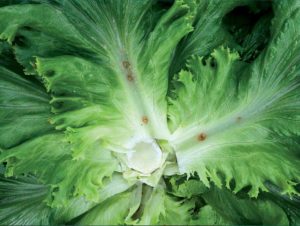Field Scouting Guide: Lygus Bug

Photo by Lisa Ames
Welcome to American Vegetable Grower® magazine’s field scouting guide. This month’s guide concentrates on Lygus hesperus (aka, lygus bug). Each month, we will bring you a different pest, ranging from weeds and diseases to insects and even wildlife.
We’ve conducted research and talked to pathologists to learn how to spot and treat this pest. This month, our information comes from Shimat V. Joseph, University of Georgia, and the University of California Agriculture and Natural Resources Statewide Integrated Pest Management Program (UC IPM).
Lygus Bug (Tarnished Plant Bug)
Scientific name: Lygus hesperus
Crops affected: A wide range of crops, including orchard fruits, vegetables, and flora in gardens and landscapes.
For example, this pest attacks strawberry, celery, alfalfa (seed and hay), lettuce, Brussels sprouts, safflower, sugarbeet, tomato, dry beans, artichoke, potato, cotton, eggplant, apple, pear, and, occasionally, oats.
Geographical range: California’s Central Coast has the ideal conditions to sustain lygus bug infestations. While the pest can cause problems elsewhere, California bears the brunt.

Lygus bug is a serious threat to many crops, including strawberries, celery, lettuce, and Brussels sprouts.
The Pest’s Impact
Joseph: The mouthpart of a lygus bug is “straw-like” and is often referred to as “piercing and sucking.” There are four needles inside the straw that are arranged in different configurations to inject saliva and suck up the digested soup. Pest populations can survive on several host plants. In strawberry, lygus bug prefers seeds, and while feeding, it injures the tissue around the embryo when the fruit is small. As these injured fruits develop, they appear misshapen and often are referred to as “cat-faced” fruits.
On vegetables, however, lygus bug injury symptoms are different. On lettuce and radicchio, the injury appears as isolated spots of dead tissue on the midrib, whereas it appears as elongated lesions on the celery stock or petiole. This injury could be due to egg-laying. Lygus bug typically inserts the barrel-shaped eggs into the plant tissue, which cause mechanical injury to the plants. Sometimes the spots on lettuce can coalesce to form a larger necrotic lesion.
UC IPM: Lygus bugs feed by injecting phytotoxins into floral structures such as flower buds or small fruit. Lygus bugs may feed on developing flower buds early in spring, causing the buds to exude gum and shrivel up. This feeding causes the floral structure to abort within days, and the structure is shed from the plant. Damage symptoms appear as dropped buds on the ground, and while there are several causes of fruit abscission (shed), lygus bugs are a primary culprit. Losses of floral structures relate directly to loss in yield as each bud or flower represents a potential fruit.
Lygus attack is more frequent in orchards that have a permanent cover crop and in orchards adjacent to crops or vegetation that host lygus. Usually, this damage is not serious unless a very heavy infestation is present. Lygus cause their most serious damage by feeding directly on fruit. Mid-season feeding results in round pits, and late-season feeding causes irregularly-shaped depressions that are similar to stink bug damage.
How to ID the Pest
UC IPM: Lygus bug adults are about a 1/4-inch long and 1/10-inch wide, and flattened on the back. They vary in color from pale green to yellowish brown with reddish-brown to black markings, and have a conspicuous triangle in the center of the back. Nymphs resemble adults, but are uniformly pale green with red-tipped antennae; larger nymphs have five black spots on the upper body surface. Nymphs do not have wings. The immature forms are pale green and look similar to an aphid. They can be distinguished from aphids by their more rapid movements. Other insects, including beneficials such as the big-eyed bug, may be confused with lygus bugs.
Joseph: Lygus bug also tends to attack at specific times that will maximize its impact. Although vegetable crops are vulnerable to lygus bug attacks throughout the growing period, the last few weeks before harvest are the most challenging for management. For example, celery is one crop that can have a problem with this pest. If lygus bug invades the early stage celery, it is relatively easy to manage using insecticide sprays because the sprays will have adequate coverage on most of the plant surface. However, during the late stages of celery when the plant canopy becomes thick, adequate spray coverage is questionable.
Similarly, the canopy of the lettuce plants closes completely during the final weeks to harvest and adequate spray coverage becomes difficult. Lygus bugs exploit these unexposed, insecticide residue-free zones within the plant to feed and develop into several colonies. Thus, if the pest population moves in at the late stages of the crop, the plant architecture and canopy favor the lygus bug to evade insecticide sprays and colonize those plants.
Recommended Treatment and Management
Joseph: Unfortunately, newer insecticides are not registered on crops such as celery. The older chemistries are restricted with one application early in the crop stage, leaving fewer options to manage lygus bug. Currently, pyrethroid insecticides are primarily used to manage this pest in California’s Central Coast.
UC IPM: Successful management of lygus includes control of weed hosts in winter, monitoring for the appearance of lygus nymphs on weed hosts and adults on strawberries in spring, and timing insecticide sprays to control lygus nymphs before they cause significant damage. Sprays must be timed to kill the earliest instars of nymphs because registered materials are not very effective on adults. It is important to limit the number of treatments for lygus, because most of the materials that are effective against lygus disrupt natural enemies of spider mites.
Biological Control
UC IPM: A parasitic wasp, Anaphes iole, which attacks lygus eggs, is available commercially and can be used for inoculative releases. It can reduce lygus populations in strawberry fields, for example, but because thresholds for this pest are very low and adults moving into the field from external sources are not controlled, economically acceptable results may not be achieved. Naturally occurring predators that feed on the nymphal stages of lygus bug include big-eyed bugs (Geocoris spp.), damsel bugs (Nabis spp.), minute pirate bugs (Orius tristicolor), and several species of spiders.
Cultural Control
UC IPM: Reduce or suppress weed host plants before fruit forms and throughout the growing season to minimize lygus populations. Yellow starthistle, sweet clover, wild mustard, and vetch are important hosts. Do not allow cover crops to dry out or to grow excessively between mowings. Crops located near alfalfa or tomato fields are at a greater risk for damage and lygus infestations may coincide with cuttings or harvest.
Growers have experimented with suction devices (bug-vacs) to control lygus bug for many years. Research has shown that an efficient bug-vac can reduce adult populations by 75% and nymphs 9% to 50%, but efficiency can vary considerably depending on the machine. If lygus bug population levels are moderate to heavy, use of vacuum machines alone will not reduce damage to acceptable levels. Vacuums may increase problems with powdery mildew and gray mold by spreading the pathogens that cause these diseases. Additionally, they may remove a disproportionately large portion of the general predator population.
Organic Controls
UC IPM: Biological and cultural controls and insecticidal soap sprays are acceptable for use on organically grown crops.










